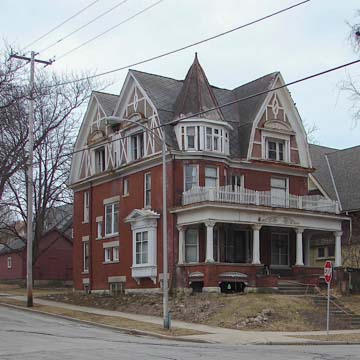Beginning in the 1840s, the industry burgeoning along the Milwaukee River created a demand for nearby housing and commerce. A bustling, mixed-use neighborhood grew on the well-drained, once-forested bluffs and plains overlooking the riverbanks. Merchants and industrialists lived cheek by jowl with laborers. The highest-profile industry combined with the distinctive local topography to name this neighborhood Brewers’ Hill.
About 1900, the city’s wealthiest German families left Brewers’ Hill for opulent new mansions on Grand (W. Wisconsin) Avenue or Highland Boulevard. Department store owner Edward Schuster and his wife Bertha stayed behind. The Schusters and others were still rich enough to build large new homes, and they used architecture to display their wealth and ethnic origin. The Schuster House’s steeply pitched gables and octagonal front tower recall Renaissance-era German manor houses. Gambrel-roofed gables on the house’s north side boast German-style false half-timbering. Straying from its vernacular design, the windows are trimmed with Baroque curved floral pediments. The lavishly detailed front porch shows German medieval-inspired cushion capitals with floral carvings in the Romanesque style.


